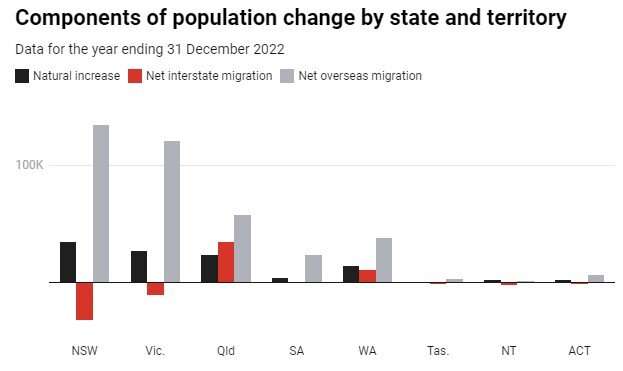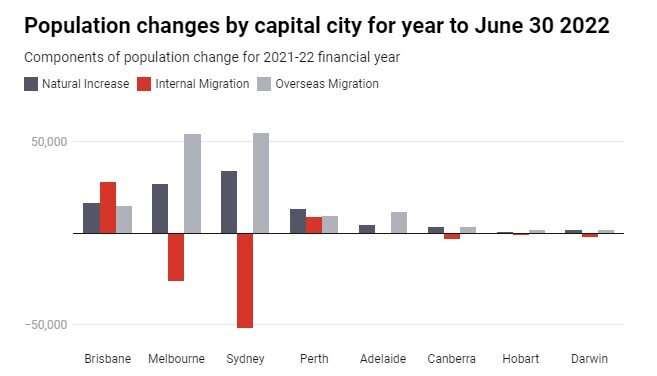This article has been reviewed according to Science X's editorial process and policies. Editors have highlighted the following attributes while ensuring the content's credibility:
fact-checked
trusted source
written by researcher(s)
proofread
COVID didn't change internal migration in Australia as much as claimed, new ABS data show

At its height, the COVID-19 pandemic disrupted well-established patterns of migration within Australia. Reports of a regional renaissance suggested city dwellers were moving to regional areas in droves. The governments of Tasmania, South Australia and the Northern Territory were also keen to promote new migration flows to reverse long-standing declines in their shares of the national population.
Advice from the Australian Bureau of Statistics (ABS) that internal migration numbers were "implausibly high" received less attention. The ABS suspended these data releases due to this concern. Its latest population data release uses a revised model for net interstate migration.
These data indicate a new normal rather than a renaissance for South Australia, the Northern Territory and Tasmania.
Internal migration losses for capital cities have also slowed.
So what was going on?
In reality, the data present a different story to the popular narrative. Pandemic-era ABS data for 2020 showed increased growth in non-metropolitan areas was due more to retaining residents than attracting new ones.
This is unsurprising. Much of Australia was in lockdown, restricting movement, and case numbers were highest in the capital cities. The historical main reasons for leaving regional areas—education and/or jobs—were no longer viable options.
In 2020, interstate migration fell by 29%. In 2021, it increased on paper by 45% compared with 2020.
However, the ABS advised this large increase was mainly due to people updating their addresses with Medicare during mass vaccination rollouts. The distorting effect of these belated updates prompted the ABS to suspend the release of regional internal migration estimates.
The under-counts and over-counts identified from the 2021 census show just how far off estimates of population and migration were for some areas. The ABS has revised its methodology, based on the census findings and updated Medicare data.
Last week, the ABS released details of its new assumptions for modeling interstate migration with the latest population data for the last quarter of 2022. Under this model, total interstate migration for 2022 fell 21%, compared with 2021, to levels similar to those of 2016.
As for movement between capital cities and regional areas within states, we have data for four quarters since March 2022 when the ABS resumed releases. ("Regional areas" include large centers like the Gold Coast, Geelong and Newcastle.) The numbers moving to greater capital cities have been increasing, and the numbers leaving have been declining. Even so, more people are still leaving capital cities than arriving (excluding overseas arrivals).
What does this mean for state and territory populations?
The revised data allow us to assess migration flows between states and territories for the last quarter of 2022 as well as back through time, including the pandemic.

In the peak pandemic year of 2020, South Australia recorded a net gain from interstate migration. The then premier attributed the reversal of the state's brain drain to its "performance in containing COVID, accelerating industrial transformation and strong jobs growth".
A closer look at the data shows the upward trend began well before the pandemic. The net loss due to interstate migration had decreased from -7,693 in 2017 to -2,885 in 2019.
The pandemic did accelerate this trend. Early in the pandemic, the net gain of 2,348 people in SA was driven by retention of people. Arrivals fell by 21.7%, but the decrease in departures was larger at 35.4%. In 2021, the net gain of 2,310 people was slightly smaller as arrivals increased by 43.6% and departures by 48.5%.
In 2022, however, the net gain was only 670 people. This suggests a return to net interstate migration losses is possible.
The revised data for the Northern Territory show a consistent net population loss to interstate migration of about 2,100 in the five years leading up to the pandemic. Then, in 2020, interstate arrivals fell considerably but departures fell even more. The result was a small net gain of 110.
When the territory's borders reopened in 2021, both arrivals and departures surged to 1.5 times the average of the five years to 2020 at 16,992 arrivals and 19,298 departures. But in 2022 both figures wound back to 14% below the five-year pre-COVID average. Departures once again outstripped arrivals, by 2,120, very close to the average net loss of 2,306 for those five years.
The Tasmanian government is refreshing its 2015 Population Growth Strategy and plans to appoint a state demographer. In November 2021, the then premier declared people were "knocking on the door, and knocking loudly" to move to the state. This was not the case.
In 2020, interstate arrivals fell by 18% and departures by 28%. The state's net gain was 2,633. For 2021, at the time of the vaccination rollout, arrivals increased by 39% and departures by 53%, resulting in a smaller net gain. For 2022, arrivals fell by 30% and departures by 16%, for a net loss of 941 people.
This reverses a seven-year period of interstate migration gains for Tasmania. With the lowest growth since 2015, the state has returned to the times before a population growth strategy. The level of natural increase (births minus deaths) is the lowest on record.
Getting the numbers right matters for us all
Claiming a population resurgence may help promote confidence for regions experiencing challenges from population aging, economic performance and/or remoteness.
The problem with such populist narratives is they may also jeopardize the development of good policy, programs and infrastructure for key services such as housing, health and education. Funding could end up going to areas with less relative need.
These narratives may also muddy the already contentious distribution of GST revenue to the states and territories. In addition, population numbers affect how many seats each state and territory has in the House of Representatives.
We need reliable and robust data to make informed decisions. This is why we should all take personal responsibility for promptly updating our home addresses with Medicare when we move. Although this might not seem urgent for individuals, not doing so may mean their share of services and infrastructure falls short of what it might otherwise be.
Provided by The Conversation
This article is republished from The Conversation under a Creative Commons license. Read the original article.![]()




















